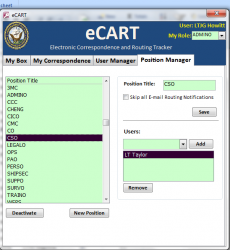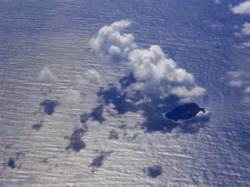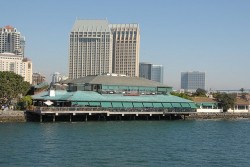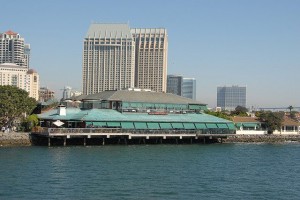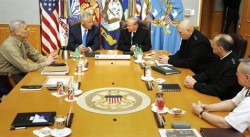Within the U.S. Navy, routing up correspondence seems fairly straightforward, but in the execution there always seems to be issues that make it anything but. In some commands, dozens of pieces of correspondence are routed per day, and in even the best commands, an occasional piece of correspondence tends to either get lost or misplaced. Conversely, if leaders aren’t accountable, correspondence may be held onto for longer than standard policy, contributing to a negative climate. Either way, it seems like locating correspondence is always a hot topic. One thing I’ve noticed, when managing an administrative department at sea, is that most of the e-mails, questions, and drop-ins we received were related to the tracking of correspondence.
There is no standard issued software to administer the routing of correspondence at sea, so we decided to create one with support from other members of the administrative department and the CMC. The software, called eCART (Electronic Correspondence and Routing Tracker), is used to track all correspondence that goes up through the ship’s office to the XO and/or CO.
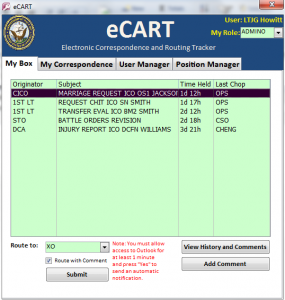
Correspondence is still placed in a traditional folder with a routing slip, however, leaders now input the correspondence name into the eCART program for tracking. When it’s hand carried to the next person that it’s going up to, the user clicks a button in eCART to mark it as being “routed” to that next position in the chop chain. The program then automatically sends them an e-mail informing them they now have custody of that certain piece of correspondence. For ease of use, the e-mail contains a link that takes them to the eCART program, where they themselves can continue routing the correspondence up the chain.
When a user is routing up correspondence via eCART, they can add comments electronically. These comments, as well as the full chain of custody with dates and times, are seen both up and down the chop chain to increase transparency in the process. When there are new comments to be read, there will be an asterisk preceding the subject that alerts the user. The interface is very straightforward and is broken into two tabs – “My box” and “My Correspondence”.

“My box” displays all the pieces of correspondence that the user’s position has custody of. “My Correspondence” displays all the originating correspondence from that user whose routing is still in progress or marked as completed/returned. For personnel that wear more than one hat, they could switch back and forth between their positions in the program by selecting their role in a drop-down box (ie: OPS may be the Safety Officer, and STRIKE may be the Legal-O). This allows any number of authorized users (even a whole office) to control one box and all receive e-mail notifications. It also allows another authorized user to fill into a position as “acting”. Thus, the routing process can still function when someone goes on leave or TAD. Since having several users control a box could create a problem with accountability, the program always logs the specific person that takes any action.
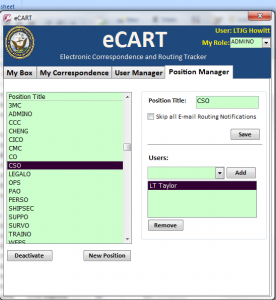
Included is a complete administrator interface, which allows designated managers to add, modify, and deactivate users and positions. There is also an option that allows the user to skip all e-mail routing notifications, which may be useful for VIP positions like the XO and CO that receive many pieces of correspondence. However, for the XO and CO, who may not want to be bothered to use the program themselves, it is more likely for designated authorized users, such as members of the ship’s office, to go in and record a change every time correspondence is transferred in or out of their boxes.
The program is built entirely on Microsoft Access. One Access file (acting as the database) is put onto a hidden directory on the ship’s shared drive or exchange server. A second Access file containing the user interface on top of 850 lines of VBA scripting acts as the client and is also put on the shared drive or exchange server as read-only and distributed to users. The client calls and communicates with the Access database on the network, which allows it to serve as a de facto software and database package, supporting up to 50 users accessing it simultaneously. The database file can easily be saved, backed up, and even transferred between LANs by simply compressing it into a zip file. The program calls and interacts with Outlook e-mail through an appropriate reference, and automatically detects the Windows’ user and alias information, so it automatically logs in the appropriate user when opening the program.
eCART is a finished product that can be deployed at any command, but is specifically intended for commands at-sea. Initially, it may be hard for all leaders in a command to adopt this new process, but with proper training, and even the implementation of policies such as one that rejects any correspondence not logged in eCART, it can easily become second nature.
Zachary Howitt is a proud American, Naval Officer, and Tech Entrepreneur. He is a designated operations analysis subspecialist and has served in two warships forward-deployed to Yokosuka, Japan. His opinions and views expressed in this post are his alone and are presented in his personal capacity. They do not necessarily represent the views of U.S. Department of Defense, the U.S. Navy, or any command.

